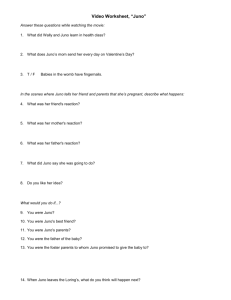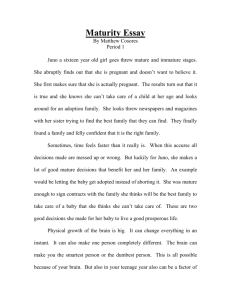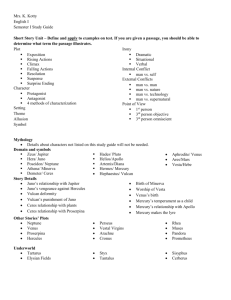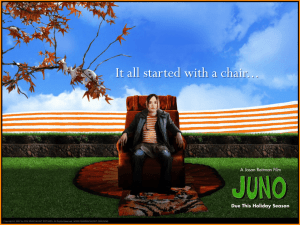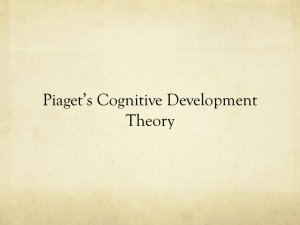Film techniques pre-test
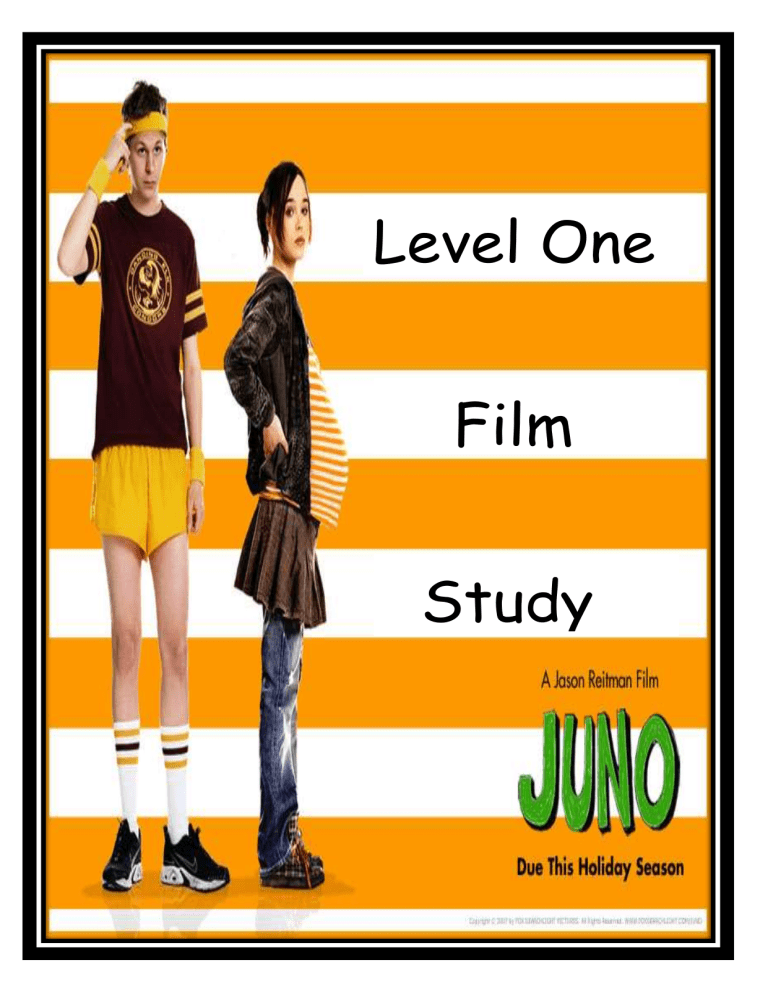
Level One
Film
Study
Created by K Davidson Te Awamutu College
Film techniques pre-test
Vocab testing
Term
Close Up
Dialogue
Long shot
Mid shot
Juxtaposition
Music
Establishing
Shot
Low Angle
Shot
Symbol
Montage
My Definition Definition after teaching and learning
'The script is really the star of the film' – Jason Bateman (Mark)
Created by K Davidson Te Awamutu College
PART ONE: Overview
Title: Juno
Director: Jason Reitman
Year of release: 2007
Characters (main):
Juno MacGuff
Paulie Bleeker
Vanessa Loring
Mark Loring
Bren MacGuff
Mac MacGuff
Leah
Setting:
Modern America
Main Theme:
Growing Up
Sub themes:
Family
Exclusion
Loss of Innocence
Symbols:
Chair
Tic Tacs
Stripes
Houses
Fingernails
Narration:
The story is told from the perspective of Juno and follows her journey through teenage pregnancy and adoption.
Created by K Davidson Te Awamutu College
PART TWO: Author and Purpose
About the Director:
Jason Reitman is an American director.
While second-generation filmmaker Jason Reitman grew up in the comic shadow of his father, director
Ivan Reitman of "Ghostbusters."
Jason described his childhood self as "a loser... a movie geek... [and] shy."
Reitman has what is described as a satirical style of film making.
Like so many teenagers, however, Reitman strove to find his own place in the world, wrestling with the belief that, if he were to pursue filmmaking as a career, people would view him as simply his father's son.
QUESTIONS:
1.
Why is the third bullet point significant for the film Juno?
____________________________________________________________
2.
What does the word satirical mean?
____________________________________________________________
3.
What characters in the film Juno are striving to find their place in the world?
____________________________________________________________
Context:
The 2000’s are an age heavily influenced by the internet and the media.
As generations get older, the younger, more impressionable generation is seeing sex as a rite of passage to become a more mature human being. Kids in general want nothing more than to be treated like they are more emotionally mature and want their parents and other peers to look up to them.
Society is becoming more liberal and having sex out of wedlock is more common which then results in higher unwanted pregnancy cases.
Abortion has become more acceptable as well. Many young women will seek an abortion if they are pregnant and don’t want the baby. In New Zealand 15-19 year olds are more likely to end a pregnancy in abortion than are 20 to 24 year olds. Almost half of all pregnancies among 15-19 year olds end in abortion.
Among the 20 to 24 age group, around a third of pregnancies end in abortion.
Created by K Davidson Te Awamutu College
QUESTIONS:
1.
How has the context of the film influenced the story?
_________________________________________________________________
_________________________________________________________________
Target Audience:
The film appeals to both teenagers and adults, partly because it has created characters of varying ages without resorting to either stereotypes or condescension.
Unusually for a movie about teenagers, it includes parents who are portrayed as decent and supportive and not idiots to be despised and ignored.
Purpose of the Text:
"Women are clever, women are funny, women are sharp, and I wanted to show that these girls were human and not the stereotypical teenage girls that we often see in the media” and "There was a lack of authentic teen girl characters ... I saw writing this screenplay as an opportunity to create an iconic female." (Reitman)
PART THREE: Plot Summary and Structure
Synopsis:
Juno a black comedy about a whip-smart, sardonic teenager dealing with a sudden and unwanted pregnancy. Instead of taking the easy way out, however, Juno decides to have the baby and allow an affluent suburban couple to adopt. But she ultimately faces very tough, adult decisions along the way, leading to a discovery of who she really is and where she truly belongs.
Plot Summary:
When Juno MacGuff, a 16-year old junior at a Minnesota high school, discovers she is pregnant by her good friend Paulie Bleeker, her first thought is to have an abortion. But she finds she can't go through with it, and so she decides to have the baby and find a good home for it.
She and her best friend Leah look in the Penny Saver where they see an advertisement from Vanessa and Mark Loring. Supported by her father Mac,
Juno arranges with the Lorings that she will give them the baby for a traditional closed adoption.
A few weeks later, Juno takes the ultrasound picture to show the Lorings.
Vanessa is not at home, but Juno discovers she and Mark, a commercial jingle composer whose rock band youth is now in cardboard boxes in the basement,
Created by K Davidson Te Awamutu College
have similar tastes in music, and in slasher movies. Vanessa is dismayed to discover Juno in her house but softens when she sees the ultrasound picture.
Juno's stepmother Bren suggests it is inappropriate for Juno to be visiting
Mark, but Juno rejects her opinion. She visits Bleeker and is embarrassed when he expresses his affection for her. She suggests an alternative girlfriend for him.
A few weeks later Juno sees Vanessa at the mall interacting with a small girl and is impressed; she encourages Vanessa to talk to the baby and feel him kicking.
Learning Bleeker is taking another girl to the prom, Juno – now nearly eight months pregnant – has a row with him. Upset, she gets in the van and visits
Mark.
They dance together, and he tells her he is leaving Vanessa. Juno is appalled.
When Vanessa arrives home, Mark tells her he is not ready to be a father and wants a divorce. While he and Vanessa discuss this, Juno leaves in tears.
After giving the matter considerable thought, Juno writes a note which she leaves on the Lorings' front porch.
Back home, she seeks comfort from her father, and thanks to his good advice, realises that she loves Bleeker. The next day, she tells him of her feelings and they kiss.
When she goes into labour, she does not tell Bleeker because he is at an important running meet. Seeing her not in the crowd, he realises what has happened and runs to the hospital where Juno has had a baby boy. While he lies on the bed with her and comforts her, Vanessa meets her new son for the first time. On the wall in the baby's nursery, Vanessa has framed Juno's note:
"Vanessa. If you're still in, I'm still in."
Juno is happy as Bleeker's girlfriend and resumes her life as a teenager.
PART FOUR: Themes
Find quotes that support the following themes…
Growing Up:
“This is a movie about teenage girls growing up too fast,
and 30-year-old men who don't want to grow up.”
(Reitman). In the film Juno is faced with an extraordinary conflict. Due to making a hasty and somewhat immature decision of having unprotected sex Juno must accept her responsibilities. These decisions that she makes about her baby are incredibly selfless and she is forced into making decisions “way above her maturity levels.” Mark also encapsulates this theme being thrown into parenthood and not being ready for it, Mark
Created by K Davidson Te Awamutu College
is desperately hanging on to his youth. The basement scene is a clear flirtation with each other's world ... that Juno wants to feel like an adult and Mark wants to feel like a kid again. Although Juno proclaims to be immature viewers understand that she is wise beyond her years She shuts down what is happening between her and Mark before it ruins their relationship, she honours the agreement between Mark and Vanessa despite their marriage breaking down, she keeps protects Bleeker by not telling everyone that he is the father and she only pursues her friend Bleeker when she knows that she is completely sure of her feelings towards him.
Quotes:
_________________________________________________________________
_________________________________________________________________
_________________________________________________________________
Functional Families:
Often in film we are exposed to the ‘perfect nuclear family’. This film looks at two ‘unconventional’ families and how they too can be loving and functional. Brenda is not the stereotypical ‘evil’ and obstructive step-mother, rather an incredibly supportive woman who may not see eye to eye with Juno but loves her like her own daughter. Mark and Vanessa ‘create’ their family from the local
‘Penny Saver’ but are just as ready to be parents as any other young couple. Juno is shocked to discover that Mark and Vanessa want to split up and runs away from their house. After a discussion with her Father Juno is able to see that family and relationships can be hard but as long as there is love it doesn’t matter.
Quotes:
_________________________________________________________________
_________________________________________________________________
_________________________________________________________________
Exclusion
:
Juno is not the typical teenager that viewers expect to see on an American film. Juno often seems to be excluded from her peers but she is a self-proclaimed ‘freaky girl.’ A dialogue in the movie shows exactly that when Juno describes about her school
Created by K Davidson Te Awamutu College
colleague that belongs to the American football with his cool jacket that has the team’s name on it and should be going out with the perfect-straight-blond-hair cheerleader girl but what he really would like to do is to go out with indie-alternative-excluded-girls like her. Being pregnant exacerbates Juno’s exclusion from her peers. Juno is herself rather than what everyone wants her to be which makes her such an inspiring and interesting character. Similar traits can be seen in the character Mark which is why the two connect so strongly. Vanessa is frustrated with Mark’s inability to grow up, due to this lack of acceptance this leads to the end of their marriage.
Quotes:
_________________________________________________________________
_________________________________________________________________
_________________________________________________________________
The Innocence of Teenagers:
Teenagers do not always have the most positive depiction in today’s media. Many teens are trying / expected to grow up too fast and are then facing situations that they are not emotionally ready for. This film celebrates the innocence of youth. Juno puts on a front but we understand she is still truly innocent. This can be seen with her recoil after Mark hits on her and her response when Bleeker asks another girl to the Prom.
Bleeker personifies innocence with his unwavering dedication to his running team and his orange tic-tacs.
Quotes:
_________________________________________________________________
_________________________________________________________________
_________________________________________________________________
Created by K Davidson Te Awamutu College
PART FIVE: Character
Juno MacGuff / Ellen Page
16, a high school junior from Minnesota, with a wicked sense of humour, a nonchalant cool and an effortless attitude
confident, frank, quick witted and genuine; scrappy, tomboyish
calls herself a "freaky girl"; Bleeker aggress with his mother that she is "different".
Her clothes set her apart. Leah dresses like a fashionable teenager; Juno dresses in anything – plaid shirts, stripey T's, jerseys and cardigans that look as if they came from an op shop.
She holds Paulie off for months - perhaps because she likes him as a friend but is afraid (after she is pregnant) to expect more from him
Intelligent and with a surprising self-knowledge: she is mature enough to know she is not mature enough to deal with a child at her age: "Dude, I'm ill-equipped."
She is blunt and outspoken, saying what she thinks without the internal censorship that comes with maturity, such as when she tells Vanessa she is lucky she is not pregnant. Tends to call a spade a spade: "blood and guts".
Actually seems more mature than she is because of her frankness and articulacy. Is naïve about relationships. She lacks the self-knowledge to appreciate Bleeker until her father's words resonate with her; when she first confirms her pregnancy, she tells Leah that "It's complicated" and evades Paulie's attempts to get closer
Ironically her journey through the months of pregnancy is not towards a spurious and forced maturity but towards a greater awareness of her lack of it: "… dealing with things way beyond my maturity level."
Questions:
1.
What is a defining scene for this character? Why?
______________________________________________________________
______________________________________________________________
______________________________________________________________
2.
Why is Juno important? Answer with the writer’s purpose and themes in mind
______________________________________________________________
______________________________________________________________
______________________________________________________________
Created by K Davidson Te Awamutu College
Paulie Bleeker / Michael Cera
a good student, who works hard at school, he anchors the emotional core of the story
charmingly unassuming, sweet without being wet or weak; is fond of Juno and is hurt by her dismissal of him
does not evade responsibility for her pregnancy but is somewhat frightened when he is first told of it by what it might mean; accepts Juno's decisions – both of them.
Gradually comes to accept the implications of the pregnancy and offers Juno genuine support and comfort when she needs it.
he is a genuine innocent with none of Juno's false maturity: Reitman: 'Bleeker is the symbol of innocence, of perfect innocence, in my world.'
Question:
1.
What key theme can we link to this minor character? How do we see this theme through this character?
_________________________________________________________________
_________________________________________________________________
_________________________________________________________________
Mark Loring / Jason Bateman
charming, likable, funny, laid back; in his thirties, earns his money – big money – writing commercials yet has not lost his dream of being a rock star
has gone along with Vanessa in her need for a baby but his heart is not in it; can be seen as dishonest, but maybe as much with himself as with her. He agrees to the advert to humour Vanessa and doesn't expect anything to come of it.
early hints to his unhappiness: "I'm the husband"; "Vanessa gave me a room for all my stuff" etc
Seeing Juno in all her youth, getting to know her and enjoy her company, makes him long for his lost youth. He misreads her infatuation as more than it is; this precipitates the crisis; is appalled when she says, "But you're old."
Mark's motivation in the basement scene with Juno is left ambiguous – it can be read as that he is coming on to her, or (as the director suggests) that he is more in love with the idea of her youth than with her.
Question:
1.
What key theme can we link to this minor character? How do we see this theme through this character?
_________________________________________________________________
_________________________________________________________________
_________________________________________________________________
Created by K Davidson Te Awamutu College
Vanessa Loring / Jennifer Garner
a successful career woman – the power suit, the silver Lexus, the expensive house all attest to this – who yet is desperate for a child. Her sincerity is made clear when she is playing with the little girl in the mall – she does not want a child just as a fashion accessory; she genuinely loves and finds pleasure in children.
she seems initially house-proud – the McMansion could have come from an interior design magazine – but this is clearly a substitute for the child she really wants; she disguises desperate nesting urges beneath suburban refinement
She is the dominant one in the marriage; it is only in retrospect that it can be seen it is because she is the only grown up in it. Initially comes through as cold and controlling; later that can be seen to have been a result of tension, over both the uncertainly of whether this baby would arrive, and over Mark's commitment
the real Vanessa is seen in the mall: a character-defining scene
Question:
1.
What key theme can we link to this minor character? How do we see this theme through this character?
_________________________________________________________________
_________________________________________________________________
_________________________________________________________________
Created by K Davidson Te Awamutu College
Part Six: Techniques
Below are some key scenes from the film that we will look at closely as a class.
The first scene is done for you to indicate the quality of the response expected.
Opening Scene
Technique
Screen text
Motif
Extreme close-up
Voice Over
Animation
Describe
‘Autumn’ is displayed on the screen in cartoonish writing.
Purpose
The seasons represent the trimesters of Juno’s pregnancy as the film follows her journey for nine months.
The chair is sitting on the lawn
Juno’s underwear
The chair is a motif of where the pregnancy began and at the end of the film it refers back to the chair as where it ended. Juno looks angrily at the chair which shows she is in despair about the news of her pregnancy.
The underwear is then kept by Bleeker and appears again throughout the film and symbolises Bleeker’s love for
Juno.
Juno’s ear and Bleeker’s lips Used to show the passion between the couple as well as the innocence of their love making by keeping it romantic rather than explicit.
Heard twice throughout the movie as a voice in Juno’s head.
Audience get their first taste of the snappy screen play and the teenage language used in the film.
Juno walks to the shop in animation Cartoon used to portray the innocence of the characters and the film.
Created by K Davidson Te Awamutu College
Abortion clinic scene
Technique
Montage
Close-up
Dialogue
Symbol
Costume
Technique
Extreme Close-Up
Sound Effects
Symbol
Dialogue
Meeting Mark and Vanessa
Describe
“Oh Hi, babies have fingernails.”
Describe Purpose
Purpose
Created by K Davidson Te Awamutu College
Music
Long Shot
Closing scene
Technique
Voice Over
Mall Scene
Technique
Long Shot
Close-up
Costume
High angle shot
Describe
Describe Purpose
Purpose
Created by K Davidson Te Awamutu College
QUESTIONS
(Choose ONE)
A list of visual and oral language features is provided on page 3.
1. Describe at least ONE friendship that was important in the text(s).
Explain how the friendship helped you to understand one or more characters or
individuals in the text(s), using examples of visual and / or oral language features to support your ideas.
2. Describe at least ONE idea that was worth learning about in the text(s).
Explain why the idea was worth learning about in the text(s) as a whole, using examples of visual and / or oral language features to support your ideas.
3. Describe at least ONE event that was a turning point in the text(s).
Explain how the event was a turning point in the text(s), using examples of visual and / or oral language features to support your ideas.
4. Describe at least ONE setting that was important in the text(s).
Explain how the setting helped you to understand one or more key ideas in the text(s), using examples of visual and / or oral language features to support your ideas.
Note: Setting is the time, place, and circumstances that form the background
against which characters or individuals live and act.
5. Describe at least ONE challenge faced by a character or individual in the text(s).
Explain how the way he / she faced the challenge helped you to understand the character or individual in the text(s), using examples of visual and / or oral language features to support your ideas.
6. Describe the opening scenes or section of the text(s).
Explain how the opening scenes or section helped you to understand what the text(s) were going to be about, using examples of visual and / or oral language features to support your ideas.
Created by K Davidson Te Awamutu College

